The State of IT Automation
Breakthrough or Buzzkill?

Automation’s Reality Check:
The allure of automation in IT is often eclipsed by reality. What begins as a promising SaaS investment can turn into a time-consuming, complex endeavor. “Seamless integrations” start to fray, the ”instant setup” never really ends, and the “user-friendly” environment becomes a labyrinth.
Today, we’re witnessing a similar hype cycle with AI (and deservedly so). However, all cycles eventually end with some degree of disappointment. As we examine IT’s relationship with automation in this report, it’s impossible not to consider the implications for AI once the hype has faded and IT simply needs a solution that works as promised.
This report, based on a survey of 200 IT professionals conducted by the Gartner Peer Community, examines the intricate dynamics between IT and automation, highlighting both triumphs and challenges to offer a deeper understanding of how to effectively harness this potent, yet elusive, technology.
Key findings of this report:
• Consistency Over Speed: IT professionals value consistency (48%) more than speed (21%) in automation.
• Automation Adoption is Lagging: Most SaaS tasks that could be automated are still done manually, and only 13% reported great success with automation.
• Barriers to Automation Remain High: 64% of IT professionals cite a lack of tool education, and 58% cite insufficient staffing or time as major challenges in automation implementation.
• Ease of Use is Paramount: Over half (54%) of IT professionals prioritize ease of use when evaluating new automation software.
Why Automate: What Does IT Really Want?
According to Gartner, we’re about to witness an explosion of automation. Gartner predicts that by 2025, 70% of organizations will implement structured automation to deliver flexibility and efficiency, an increase from just 20% of organizations in 2021.
With that influx of automation, surely the goal is increased speed—right? Well, not necessarily. While speed often garners all the attention in the realm of automation, our survey showed that IT pros prefer reliability and consistency over the flash and sizzle of speed.
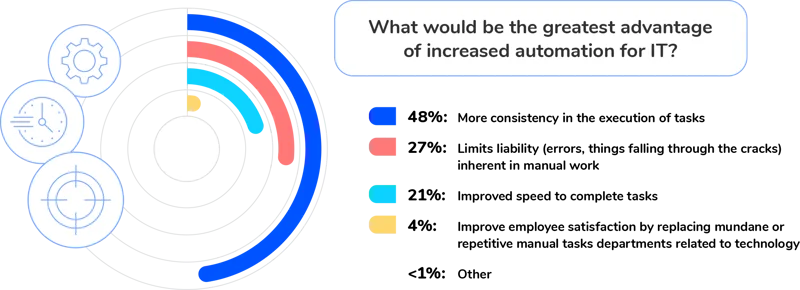
The survey says a solid 48% really want consistent task execution, while 27% appreciated the proverbial safety net limiting liability and reducing errors. This speaks volumes about the unsung merits of automation. Speed, you ask? Just 21% favored it as the star performer.
And this makes sense when you think about it. Speed without reliability can actually add more work than it saves. Going faster in the wrong direction will only increase the problem.
Big Takeaway: Software vendors are quick to point to speed and productivity as the top advantage of automation, but IT pros value predictability and liability reduction far more.
And the overall sentiment about automation? Unwaveringly positive. Despite occasional bouts of frustration and disconnect, a whopping 92% of IT pros are still championing this tech evolution. Remember, automation may not be all sunshine and rainbows, but it’s a ride that IT professionals are ready, willing, and remarkably upbeat to undertake.
The Automation Dilemma

Now for the flip side, we explored the barricades that prevent IT from reaping automation’s full benefits. According to the survey, a resounding 64% of respondents mentioned an ‘educational gap’ about tools as a substantial barrier. ‘Lack of time’ and ‘insufficient staffing to invest in automation’ ran a close second, identified by 58% of respondents.
The challenges don’t end here. In fact, a significant 44% of IT pros voiced concerns regarding ‘poorly designed automation tools.’ Interestingly, only 23% of respondents said their barrier was budgetary.
Big Takeaway: The reality of automation is a far cry from the well-crafted utopia we’re often sold. Products might promise effortless automation, but the hurdles of time constraints and poorly designed tools continue to weigh down IT’s ambitions. In essence, automation, as it stands, could be more of a Herculean task than it’s worth, it’s up to vendors to prove that it’s not.
Commonly Automated Tasks
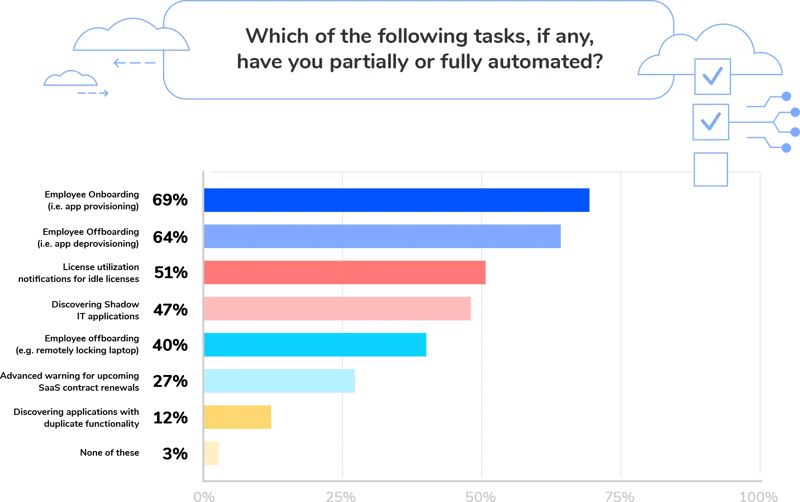
When examining tasks within IT’s realm that are partially or wholly automated, there’s a wide variation of responses. An impressive 69% of respondents reported partial to full automation in ’employee onboarding,’ while ’employee offboarding’ was similarly treated by 64% of IT personnel. License utilization notifications for idle licenses’ was cited in 51% of instances, and ‘discovering Shadow IT applications’ in 47%.
Additionally, 40% of respondents mentioned partial automation for ’employee offboarding tasks like remotely locking laptops.’ Advanced warnings for upcoming SaaS contract renewals’ and ‘discovering applications with duplicate functionality’ were automated to some extent by only 27% and 12% of respondents respectively.
Big Takeaway: Surprisingly, even with a low bar set by partial automation, most responses hovered around or below the 50% mark. This not only brings the actual adoption and reliability of automation solutions into question but also speaks volumes about potential disillusionment among IT professionals due to factors like poor user experience, lacking education, and inconsistent results. One alarming observation: over half of respondents (53%) lack any form of automation to discover Shadow IT – a significant security concern in today’s IT landscape.
Note: It’s worth noting that both offboarding and license utilization automation are highly dependent upon the effective discovery of unsanctioned SaaS applications—a common blindspot for companies. Without real-time comprehensive discovery, which is only possible with automation, offboarding and license management can’t be effective as they only cover a portion of a business’ true app portfolio.
• Read Torii’s Visibility and Impact study to learn more about Shadow IT trends
• Learn why 76% of IT pros consider offboarding their greatest SaaS security threat
Finally, while a notable 84% of respondents believe their companies have had some success in improving efficiency with automation, only a small fraction (13%) report ‘great success,’ indicating huge opportunities for improvement.
The Cost of Automation
In our exploration of IT’s relationship with automation, we also delve into spending patterns on technology, with a keen focus on Software as a Service (SaaS) expenditures. IT budgets, despite economic constraints, are undeterred when it comes to SaaS. A striking 86% of IT leaders confirm that SaaS consumes at least 21% of their overall budget.
In 2023, 79% foresee a ‘moderate’ or ‘great’ increase in SaaS spending within their organizations. On the other hand, only 3% anticipate a decrease in their SaaS budget.
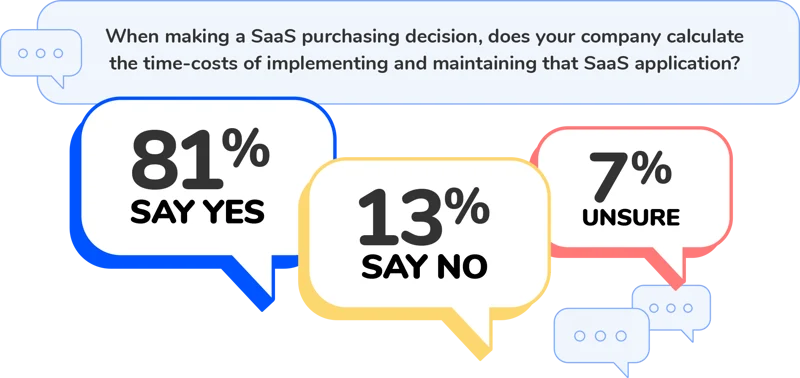
However, it’s not just about the financial outlay; implementation costs are also on IT professionals’ radar. When asked if the time-cost of implementing and maintaining automation tools is a consideration, a significant 81% said it is, indeed, a consideration. Conversely, 13% don’t take this factor into account, and the remaining 7% are uncertain.
Big Takeaway: While financial costs are a tangible metric, the ‘time cost’ is equally important to IT pros. In many ways, this confirms our earlier result. 58% had said time or headcount was a barrier, while only 23% said lack of budget was the constraint.
Charting the Course: The Future of Automation in IT
As SaaS ecosystems grow in complexity, automation solutions need to evolve to meet changing needs. What IT professionals seek in automation tools reflects not just their current challenges, but their expectations and hopes for the future.
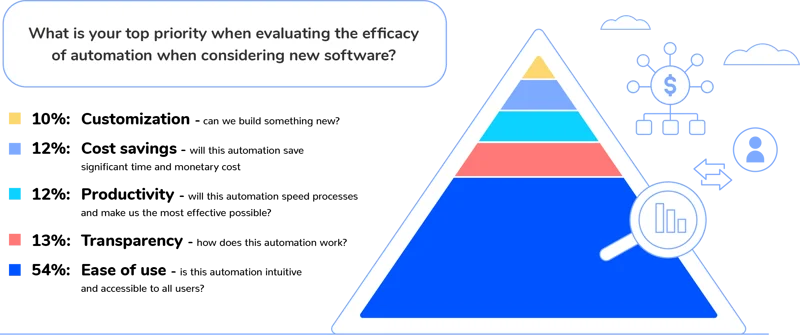
Our survey explores the main factors that IT professionals consider when evaluating automation in new software. A surprising majority—54% of respondents—said ‘ease of use.’ They value solutions that are intuitive and accessible, underscoring the need for automation tools to be user-friendly above all else. Without this attribute, even the most robust automation capabilities risk becoming just another drain on time and resources–and ultimately discarded.
The remaining “evaluation criteria” responses were evenly split, highlighting the diversity of needs amongst IT pros. Some focused on transparency (13%), eager to understand how automation works, while others focused on cost savings (12%) and productivity (12%), recognizing the crucial role of automation in enhancing efficiency and reducing expenditure. A smaller but significant number prioritized customization (10%), demonstrating the need for flexible solutions that can be tailored to meet specific business requirements.
Big Takeaway: Automation tools need to be user-friendly. No other criteria compares. All the promises in the world can’t hold weight without the ability to actually implement the technology. IT professionals, already stretched thin for time, understand this all too well.
Going Forward: Making Automation Buzzworthy
While automation is an exciting prospect, it also presents its fair share of complexities and challenges. Our survey found that the narrative around automation should focus on more than speed. Consistency, reliability, and ease of use are just as, if not more, important.
So, returning to our original question. Is automation a breakthrough or a buzzkill? A little bit of both. The glaring educational gap, time constraints, and poorly designed tools have emerged as prominent barriers. However, even amid these hurdles, IT teams are unfalteringly positive toward automation.
The key takeaway is that automation is more of an evolution than a revolution. As we navigate toward the future, it’s critical to realize that the true power of automation lies not in its flashy promises, but in its practical, user-friendly application that aligns with the needs and realities of IT professionals.
About the Survey:
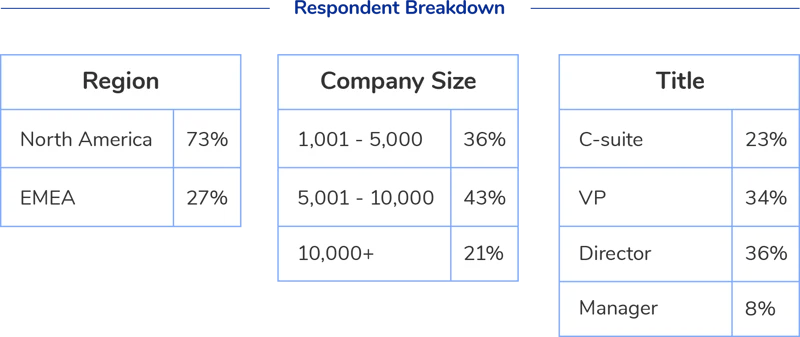
On behalf of Torii, Gartner Peer Community surveyed 200 IT pros: Managers, Directors, VPs, and C-suite (CIOs). All data was cleaned and verified by Gartner’s data analyst team.
In the survey, we probed sentiments, hurdles, expectations, and musings on IT. Questions spanned teams, individuals, and the IT role as a whole. For more questions and answers, check out the infographic report.
